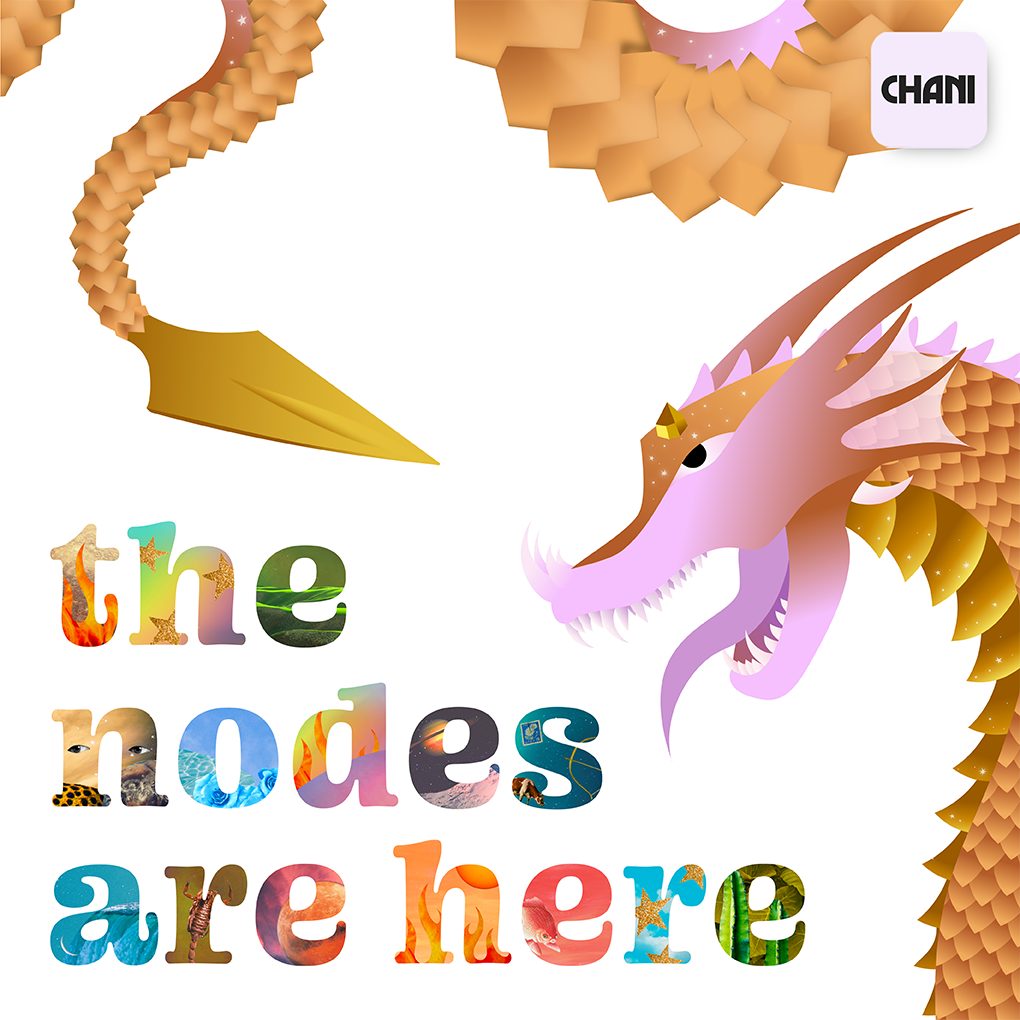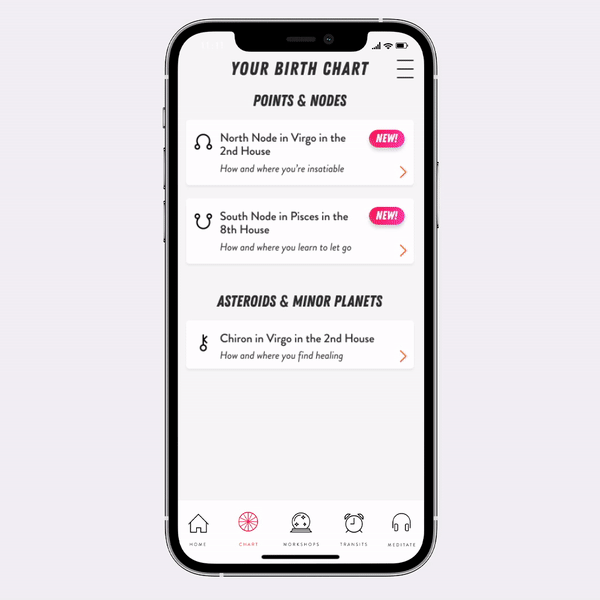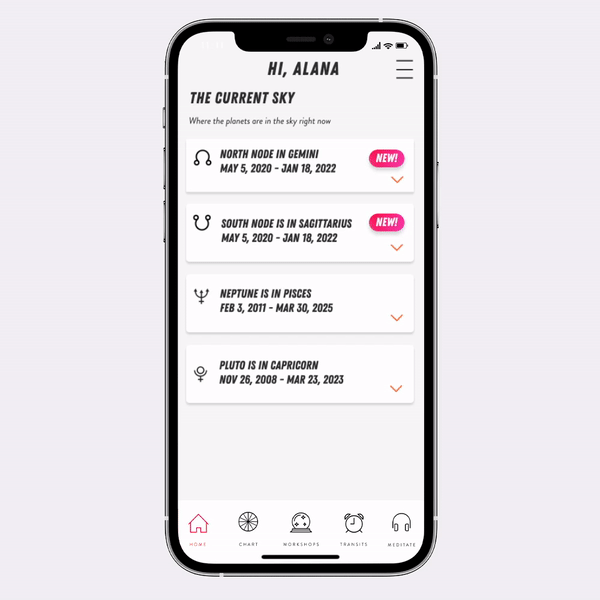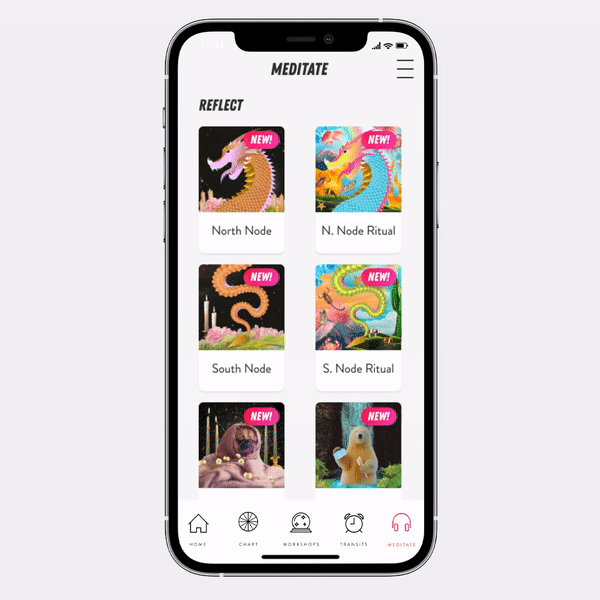We are happy to unlock the next feature of the CHANI app: the lunar nodes. These complex points in space have been mythologized as the head and tail of an insatiable dragon.
In your natal chart, the north knot, or the head of the dragon, indicates an area of life where you are insatiable. No matter how hard you try and search and sweat, that hunger is limitless. It cannot be filled.
The south knot is the dragon’s tail: a point of surrender. Here you ring the bell, renounce, liberate. Like food poisoning cleaning you up, this process is necessary, albeit rarely a pleasant one. The South Node is a mechanism by which the body, mind and heart purify themselves.
At these points eclipses occur. When a new or full moon occurs near the north or south node (every 6 months), the lights are temporarily extinguished. Because of this, the ancients viewed the lunar nodes as danger zones.
Work with the nodes in the CHANI app in 3 ways:
1. Learn more about your natal North and South Nodes and how they interact with other planets in your chart
2. Discover how the journeys of the Nodes through Gemini and Sagittarius affect you in the Stream Heaven.
3. Work with our new meditations and rituals for the North and South Nodes
Don’t see The Nodes? Try closing and reopening your app. If that doesn’t work, read how to update the app here.
frequently asked Questions
1. What are the lunar nodes?
From an astronomical point of view, the lunar nodes are the two points in space where the orbit of the moon around the earth intersects with the ecliptic (d in a diagram always opposite one another (i.e. separated by 180 °).
In many cultures the lunar knots were depicted as dragons. The north knot represents the head of the dragon – according to Hellenistic and medieval astrologers, an ascent point. The south knot or the tail of the kite, on the other hand, denotes a decline. A surrender.
2. How does the CHANI app approach the nodes?
While many modern and evolutionary astrologers tend to read soul journeys into the lunar nodes, these points have traditionally been viewed as danger zones. When a new or full moon occurs near one of the lunar nodes: eclipses occur. The lights we live on have temporarily gone out.
Although this fear is hard to reproduce these days when so much of our light is artificial, imagine moving through a train station or office building when all the lights go out without warning. In the sudden darkness a panic or disorientation sets in.
Now imagine relying on these lights for body heat, eyesight, farming, and all kinds of daytime activities. You may even perceive divine intelligence in these lights: you pray to them and leave offerings. Then suddenly: they are extinguished. It would be an ominous sign, to say the least.
We see the lunar nodes as two points that push us to extremes: excessive hunger in the north knot and excessive releasing or renunciation of the south knot. Like any balancing act, our knot work requires attention and adjustment. It is not comfortable to dwell on either extreme for too long.
3. How do the nodes move?
The lunar nodes move backwards through the zodiac, which is why they are likely to appear retrograde in your chart, although their actual movements tend to wobble back and forth. These nodes are always facing each other, and they spend 18 months in each axis and sweep the entire zodiac every 18.5 years.
According to the “true” calculation, the lunar nodes entered Gemini and Sagittarius in spring 2020 and will remain on this axis until January 2022. During this time, you may notice a hungry enlargement in the twin corner of your chart as you experience ritual devotion or liberation in the part of the chart that Sagittarius is in.
4. My nodes in the CHANI app are in a different location than I am used to. Why?
The lunar nodes always move backwards on the map, but their real movements tend to wobble between retrograde and direct movement.
the mean The calculation smooths out these small wobbles by taking a mathematical average of the total movement.
the true The calculation reflects the exact location of the nodes at a given point in time and not the mathematical average.
There may be discrepancies between true and mean Calculations up to 1 ° 45 ‘. For a few people, that’s enough for the nodes to change the sign and house depending on which calculation you’re using.
The CHANI app uses the true Calculation for the lunar nodes. If you are used to seeing your horoscope from an astrologer or astrology software, the mean Calculation, this can mean that your nodes change sign.
5. Are the “true” knots truer?
Not necessarily. While true computation is the most mathematically accurate place, astrology is an area that tends to make way for less materialistic forms of knowledge. Just like when choosing a house system, many astrologers decide early in their practice whether to work with the true or mean knots.
You can think of it like a chef working in metric or imperial formats. There is no “perfect” conversion between a cup of flour and 136 grams unless you pour that cup onto a graduated scale to get the exact mass. Even so, it’s probably pretty tight.
6. What does it mean if my true and mean nodes have different signs?
There is no clear answer to that. Some people agree on both placements while others feel more attached to one calculation than the other.
Just as a planet on your diagram can change houses depending on the house system used, both calculations can have a value. It’s just a change of perspective.
If you find a discrepancy with other apps or astrologers, we invite you to consider both options for yourself and think about what feels true to you.
7. Does the angular relationship between the nodes ever change?
No. The north node of the moon is always 180 ° away from the south node. This means that they will always be in opposite signs.
8. What do the lunar nodes have to do with eclipses?
Although the sun is 400 times larger than the moon, it is also 400 times farther away. In other words, from our point of view, they look roughly the same size.
Remember that the moon’s nodes reflect the intersections between the lunar orbit and the sun’s orbit in the sky from our view of earth. This means that as the sun approaches the traversing lunar nodes, the earth, sun, and moon fall in proper alignment so that one of our lights blocks the light of the other.
Eclipses are always new or full moon – they do not occur in any other phase of the lunar cycle. When a Full moon occurs within 11 ° 38 ′ of the north or south node, a lunar eclipse happens. When a new moon occurs within 17 ° 25 ′ of the north or south node, there is a Solar eclipse.
This is why the eclipse season happens every 6 months: because it takes the sun 6 months to travel from one side of the zodiac (and the lunar node) to the other.
9. Do the transit nodes come in Taurus / Scorpio in December or January?
The “real” moon nodes that we use in the CHANI app are entered from Gemini / Sagittarius Taurus / Scorpio January 18, 2022.
The “middle” lunar nodes will change their signs 12/22/2022.
10. This interpretation is a little different from what I’m used to. Why?
Many modern astrologers interpret ideas around karma and soul journeys into the lunar nodes. In evolutionary astrology, the south knot represents where we come from, including previous life experiences or past egos, while the north knot represents where we are going.
There’s nothing wrong with this approach, but the CHANI app is rooted in more traditional techniques. Most Hellenistic and medieval astrologers viewed the knots as points of danger because of their association with eclipses. They also saw the north knot as an amplifier or rise point, while the south knot could serve as a cosmic drain valve.
While medieval and Hellenistic astrologers treated the knots with some caution, many also suggested that the north knot might increase the welfare of benevolent planets like Venus or Jupiter, while the south knot might decrease their helpfulness. The same goes for the evil planets like Mars and Saturn. The north knot would, in theory, increase the challenges while the south knot could decrease them – but there is room for nuance here.
11. Why is there a solar eclipse in Taurus in November 2021 when the nodes are currently in Gemini and Sagittarius?
Eclipses occur when the sun is within 15 ° or so of any of the nodes. November 19, 2021, the true north knot is at 1 ° 41 ‘Gemini, while the full moon is at 27 ° 14’ Taurus. Although the sign of the moon differs from that of the north knot, they are very close, only a few degrees apart.
Eclipses are determined by the degree of the new or full moon, not the degree of the nodes. So while the true knots are still in the Gemini-Sagittarius axis for another two months, the lunar eclipse itself takes place in Taurus. This usually happens when the nodes are near changing signs, as is now the case.
The last solar eclipse on the Gemini-Sagittarius axis will be on 3rd of December at 12 ° Sagittarius.
12. What does it mean if my nodes are (or not) retrograde?
The lunar nodes always move backwards (or retrograde) around the zodiac. While the true movement of the nodes fluctuates, fluctuating between retrograde and direct stations, their movements always proceed backwards.
If your nodes don’t appear retrograde on a graph, it is likely because you happened to be born in a moment when they were stationary. This has no meaning. Their usual retrograde movement is also irrelevant.
13. Are the nodes physical bodies, such as planets or asteroids?
No. From our point of view on earth, the lunar nodes reflect the geometrically calculated points at which the orbit of the moon intersects the orbit of the sun. Unlike planets and asteroids, they have neither body nor mass.
14. Do other planets or bodies in space have nodes?
Yes sir. Every planet has an orbit, which from our point of view on earth intersects with the orbit of the sun. Hence, every planet has nodes.
15. Are there other names for the lunar nodes?
The north knot is also known (by astronomers) as the ascending knot; caput draconis (from medieval or Renaissance astrologers); and Rahu (from astrologers in India.)
The south knot is also known (by astronomers) as the descending knot; cauda draconis (from astrologers of the Middle Ages or the Renaissance who worked in Latin); and Ketu (from astrologers in India.)





